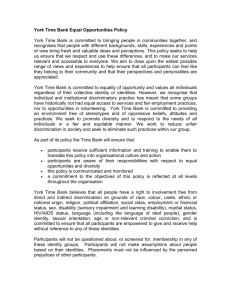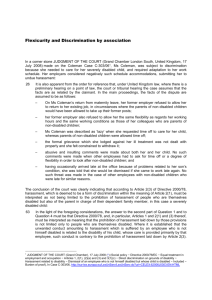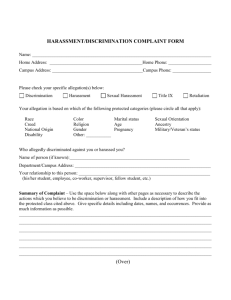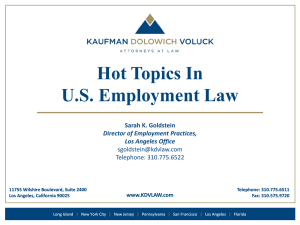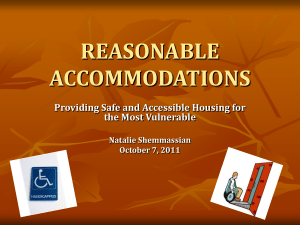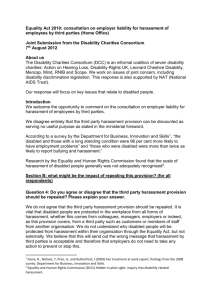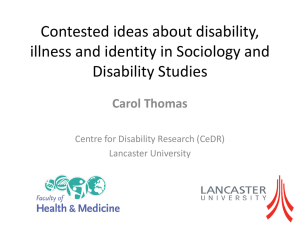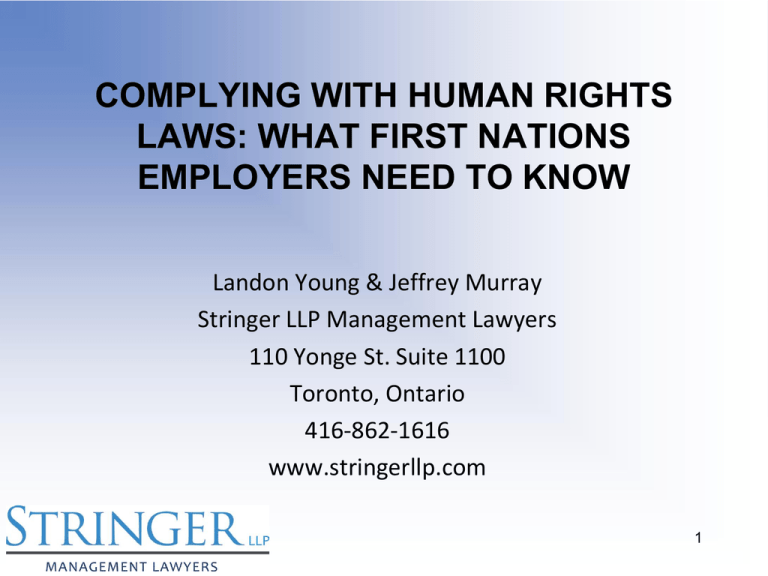
COMPLYING WITH HUMAN RIGHTS
LAWS: WHAT FIRST NATIONS
EMPLOYERS NEED TO KNOW
Landon Young & Jeffrey Murray
Stringer LLP Management Lawyers
110 Yonge St. Suite 1100
Toronto, Ontario
416-862-1616
www.stringerllp.com
1
Human Rights Legislation
Federal: Canadian Human Rights Act (CHRA)
Provincial: Ontario Human Rights Code
Legal principles are similar although
enforcement mechanisms vary
CHRA Interpretive Provision
1.2 In relation to a complaint made under the
Canadian Human Rights Act against a First Nation
government, including a band council, tribal council or
governing authority operating or administering
programs and services under the Indian Act, this Act
shall be interpreted and applied in a manner that gives
due regard to First Nations legal traditions and
customary laws, particularly the balancing of individual
rights and interests against collective rights and
interests.
CRHC Aboriginal Employment
Preferences Policy
Employers may have preferential hiring and
employment practices for Aboriginal
individuals
S. 16 of the CHRA exemption for
discriminatory practices designed to prevent
disadvantages that are likely to be suffered by
a group of individuals
Prohibited Grounds of
Discrimination (Federal)
Race
Sex
Marital Status
Citizenship
Disability
Family Status
Colour
National or Ethnic origin
Religion
Sexual orientation
Conviction for pardoned
criminal offence or where
record suspension
ordered
Ancestry
Age
Indirect or “Adverse Effect”
Discrimination
Workplace rules or procedures may be contrary to
human rights legislation if they have a
discriminatory effect
Particularly common areas of such discrimination
include age, gender, disability, religion, family status
6
Indirect or “Adverse Effect”
Discrimination – The “BFOR”
Exemption
A rule or requirement that has a discriminatory
effect may be permitted if the requirement is
reasonable and “bona fide” (sometimes referred to
as a “BFOR”)
7
Examples of Workplace
Practices With Discriminatory
Effects
Mandatory attendance policy
Physical requirements for a job that are not
reasonable
Random drug or alcohol testing
Preferential hiring, promotion or retention of
younger employees
Disabilities
May be illness or injury
May be physical or mental
May be work related or not
Disabilities may include partial or temporary
disabilities or impairments
Discrimination because of a perceived
disability is prohibited even if the employee is
not actually disabled
Accommodation of Disabled
Employees
Employers have a duty to accommodate
disabled employees to the point of “undue
hardship”
Employer can still require that disabled
employees be able to perform the essential
duties of a job
10
Accommodation of Disabled
Employees
Accommodation is a two-way street: the employee
must cooperate with the employer’s efforts to
accommodate
The employer is entitled to relevant medical
information to determine if it can accommodate the
employee
Employees who are away from work for a
considerable period of time with no reasonable
prospect of return may be terminated
11
Attendance Management and
Disabled Employees
Employees with disabilities are protected
from discipline or termination due to
absenteeism as a result of a disability
Employer may terminate if the employee’s
absenteeism creates an undue hardship
Attendance Management and
Disabled Employees
First Step: Distinguish between “culpable” and
“non-culpable” absenteeism
Culpable absenteeism can be grounds for
discipline and, if persistent, termination
If the absence is due to the disability => nonculpable
Terminating Disabled
Employees
Ensure all reasonable efforts to accommodate
have been made
Document efforts at accommodation
For employees on an extended long term
disability leave make sure to obtain medical
information first to confirm there is no
reasonable prospect of return to work in the
foreseeable future
Drug & Alcohol Addictions
Drug and alcohol addictions are considered a
“disability”
Legitimate employee addictions must be
accommodated to the point of “undue
hardship” like other disabilities
Drug testing generally considered
discriminatory on the basis of disability
15
Family Status
There is a growing body of caselaw imposing
duties on employers to accommodate
employees with special family responsibilities
Precise scope and extent of the duty depends
on the circumstances
Examples of potentially required
accommodation include flex hours, reduced
hours and leaves of absence
16
Canada v. Johnstone
Employee was working rotating shifts
Employee asked for accommodation in shifts due
to child care responsibilities
Employee had to reduce hours to part-time
status
Child care duties covered by “family status”
Employer violated the Act
Employer should have attempted to
accommodate
Harassment
Harassment based on a prohibited ground of
discrimination is prohibited
Employers may be liable for harassment
committed by managers or supervisors
Employers have a duty to provide a
harassment free workplace
Sexual Harassment
Means any harassment of a sexual nature
May include the following:
• Jokes of a sexual nature
• Unwanted compliments regarding appearance
• Repeated, unwanted asking out on dates or for
social meetings
• Sharing personal, intimate details
• Distributing obscene pictures or videos to coworkers
Responding to Allegations of
Harassment or Discrimination
Ask for complaint to be put in writing
Conduct an investigation
• Interview potential witnesses
• Take statements
• Preserve any electronic evidence (e-mails, text
messages, etc.)
• Avoid making conclusions based on hearsay or
rumours
Responding to Allegations of
Harassment or Discrimination
If complaint is substantiated options may
include:
Counseling
Disciplinary action (warning, suspension)
Demotion
Termination
Human Rights Enforcement
Process (Federal)
1. Complaint to the Canadian Human Rights
Commission
•
•
•
Mediation
Investigation
May dismiss complaint or refer to the Tribunal
2. Canadian Human Rights Tribunal
•
•
Formal hearing and/or mediation
Decision and, if complaint substantiated,
remedial orders
Tribunal’s Remedial Powers
Order adoption of a special plan or program
Reinstate employee
Award for lost wages and compensation for
loss of job
Award for pain and suffering (max. $20,000)

